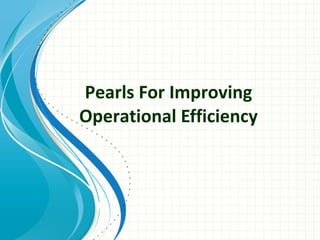
Pearls For Improving Operational Efficiency
- 1. Pearls For Improving Operational Efficiency
- 2. We are going to be introducing a social contract that deals with the relationships between each team member, and between the team and the organisation.
- 3. Scrum doesn't solve all your problems. It just makes them visible.
- 4. Collocation • Research has shown that only 7% of communication is the content of the message • The rest is body language, voice tone, context
- 5. How often distributed team members communicate.
- 6. The effects of task switching
- 7. Most productive team size based on extensive research and study. 6+-3 Paths of communication = n(n-1)/2 6 member team = 15 paths. 7 member team = 21 paths. 5 member team = 10 paths.
- 8. Technical debt • Comes from work that is not really "Done" • Has to be paid at some point, unless your plan includes bankruptcy • Hidden, undone work accumulates
- 9. Forms of Technical Debt • Defects • Lack of automated build • High code complexity • Lack of automated deployment • Lack of unit tests • Highly coupled code • Business Logic in the wrong places • Too few acceptance tests • High cyclomatic complexity • Duplicated code or modules • Unreadable / hard to read names or algorithms
- 10. Technical Debt is a Crisis in our Profession • Customers or Stake holders believe they can demand something and it can be done • Developers willingly or unconscionably cut quality to support the belief • Results includeDevelopers and customers resent the profession,Failing products, failing companies, and hateful work.We are there now
- 11. How did we get here? • It takes 3-10 years for an organisation to back itself into this corner • Once in this corner, your competition can develop & deliver new functionality much faster than you • For every $ of competitive advantage gained by cutting quality, it costs $4 to restore it • Software is an organizational asset and decisions to cut quality must be made by executive management and reflected in the financial statements
- 12. Paying back technical debt 1.Stop creating debt 2.Make a small payment each and every Sprint
- 13. Team must solve their own problems • It’s the SM’s job to enable the team to do this. • Not to solve the problems for them. • (self managing)
- 14. What is the Sprint Review for? • This is the stake holders opportunity to provide input into what they see the most important work items are to be worked on next. • A collaborative working session, not just a demonstration.
- 15. Where we are
- 16. Where we are going
- 17. Scrum Roles Demo
Editor's Notes
- This template can be used as a starter file for presenting training materials in a group setting. Sections Right-click on a slide to add sections. Sections can help to organize your slides or facilitate collaboration between multiple authors. Notes Use the Notes section for delivery notes or to provide additional details for the audience. View these notes in Presentation View during your presentation. Keep in mind the font size (important for accessibility, visibility, videotaping, and online production) Coordinated colors Pay particular attention to the graphs, charts, and text boxes. Consider that attendees will print in black and white or grayscale. Run a test print to make sure your colors work when printed in pure black and white and grayscale. Graphics, tables, and graphs Keep it simple: If possible, use consistent, non-distracting styles and colors. Label all graphs and tables.
- Give a brief overview of the presentation. Describe the major focus of the presentation and why it is important. Introduce each of the major topics. To provide a road map for the audience, you can repeat this Overview slide throughout the presentation, highlighting the particular topic you will discuss next.
- This is another option for an Overview slides using transitions.
- This is another option for an Overview slide.
- What will the audience be able to do after this training is complete? Briefly describe each objective how the audience will benefit from this presentation.
- Use a section header for each of the topics, so there is a clear transition to the audience.
- Keep it brief. Make your text as brief as possible to maintain a larger font size.
- Microsoft Engineering Excellence Microsoft Confidential
- Microsoft Engineering Excellence Microsoft Confidential If there is relevant video content, such as a case study video, demo of a product, or other training materials, include it in the presentation as well.
- Microsoft Engineering Excellence Microsoft Confidential If there is relevant video content, such as a case study video, demo of a product, or other training materials, include it in the presentation as well.
- Microsoft Engineering Excellence Microsoft Confidential
